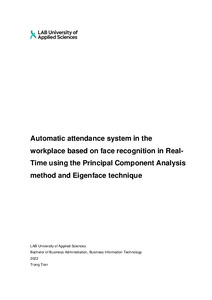Automatic attendance system in the workplace based on face recognition in Real-Time using the Principal Component Analysis method and Eigenface technique
Tran, Trang (2022)
Tran, Trang
2022
All rights reserved. This publication is copyrighted. You may download, display and print it for Your own personal use. Commercial use is prohibited.
Julkaisun pysyvä osoite on
https://urn.fi/URN:NBN:fi:amk-2022112924859
https://urn.fi/URN:NBN:fi:amk-2022112924859
Tiivistelmä
As attendance is a necessary activity for every company to determine the working time of an individual, many attendance methods have since been developed to meet the needs and be widely applied, such as PIN codes, fingerprints, key cards, etc. However, each method has its own pros and cons. Since the COVID-19 pandemic occurred, the physical contact-required attendance methods became a big problem when the virus was transmitted through direct contact, so a suitable alternative was needed. Therefore, the goal of the thesis is to provide a solution for automatic attendance using facial recognition in the corporate environment to replace other methods that require physical contact. The research aims to figure out how to automate employee attendance procedures using facial recognition applied the Principal Component Analysis (PCA) method and Eigenface technique as well as develop an efficient working real-time face recognition-based automatic attendance application.
The thesis applies an inductive approach and uses primary data as well as both primary and secondary sources of information. Primary and secondary sources are utilized in the theoretical part to form the theory base, including the knowledge of facial recognition technology, the PCA method and Eigenface technique, and the introduction to tools used in the research.
The empirical part is about obtaining and analysing the primary data. It is based on the Design Science Research method and the design cycles including designing, building, demonstrating, and evaluating are implemented to gather and analyse both qualitative and quantitative result data.
According to the empirical results of this research, employee attendance procedures in the workplace can be automated by applying a real-time facial recognition-based automatic attendance system using the PCA method and Eigenface technique, and an efficient working application is successfully researched and built to replace other physical contact-required attendance methods. The application is able to recognize faces and then employees’ attendance data would be correctly marked up in the database. This is the source to produce attendance reports by time and department. A problem of recording wrong attendance data due to misrecognition in the first milliseconds when the face is entering the frame is solved successfully by a delay solution. Additionally, the results also show that the recognizer function’s Eigen Distance Threshold (EDT) parameter values from 1300 to 1350 would produce a recognition success rate of 100%. In this range, the EDT parameter value at 1350 is chosen as the optimal value in this study to optimize not only the recognition success rate but also the recognition speed.
The thesis applies an inductive approach and uses primary data as well as both primary and secondary sources of information. Primary and secondary sources are utilized in the theoretical part to form the theory base, including the knowledge of facial recognition technology, the PCA method and Eigenface technique, and the introduction to tools used in the research.
The empirical part is about obtaining and analysing the primary data. It is based on the Design Science Research method and the design cycles including designing, building, demonstrating, and evaluating are implemented to gather and analyse both qualitative and quantitative result data.
According to the empirical results of this research, employee attendance procedures in the workplace can be automated by applying a real-time facial recognition-based automatic attendance system using the PCA method and Eigenface technique, and an efficient working application is successfully researched and built to replace other physical contact-required attendance methods. The application is able to recognize faces and then employees’ attendance data would be correctly marked up in the database. This is the source to produce attendance reports by time and department. A problem of recording wrong attendance data due to misrecognition in the first milliseconds when the face is entering the frame is solved successfully by a delay solution. Additionally, the results also show that the recognizer function’s Eigen Distance Threshold (EDT) parameter values from 1300 to 1350 would produce a recognition success rate of 100%. In this range, the EDT parameter value at 1350 is chosen as the optimal value in this study to optimize not only the recognition success rate but also the recognition speed.
